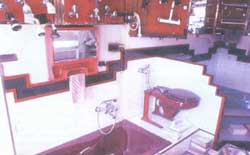The drowning of a city
 Of thirsty queues and 400 litre bathtubs
Of thirsty queues and 400 litre bathtubs
This is where the poor subsidise the water mania of the rich while the land dries up
DELHI is a city with two stark antipodes. Two-and-a-half, come to think of it. Guzzlers: that man in Golf Links, upto his neck and kneecaps in a 400-litre bathtub. Drymouths: a jam-packed, viciously frustrated queue to a tap dribbling erratically in a jhuggi-jhonpri colony in West Delhi. Half of one is half of the other: the outsized middle class, with a hope-giving lick of water an hour in the morning, an hour at night, from a city administration it sullenly views as capricious.
So when Haryana clipped water supply to Delhi by 227 mid (million litres a day) on January 10 this winter, Delhi's power-hyped officials shrilly accused it of aggravating the perennial water crisis. Meanwhile, an equal quantity of water leaked as usual that day out of badly maintained pipelines and faucets, sufficient water for two north Indian cities with populations of 1 million each.
Delhi demands, and gets, about 2,110 mld of surface water from the adjoining states of Haryana, Rajasthan and Uttar Pradesh. Despite the scarcity and there is one despite the deluge - 10 million Delhiites gorge more water than anywhere else in the country. The neighbouring cities of Meerut, Kanpur and Chandigarh, which endure similar environmental conditions, have a per capita water consumption half that of Delhi's 250 litres.
One of the city's benedictions is its "special status". The director (planning) of the Delhi Development Authority (DDA), R G Gupta says, "Delhi needs its better standards. It is the capital and India's window to the world." But, unsatisfied still, the administration has set a consumption target of 320 Ipcd (litres per capita daily) by 1997, the end of the Eighth Five Year Plan. Ideally, the government says, it would like to inundate the city's 26 expected 13 million denizens in 360 Ipcd by 2001 - a consumption more voracious than most cities in the developed world today.
But Delhi and its adjoining areas are fast exhausting their water resources. Says S C Sharma, the director of the Central Ground Water Board (CGWB), "Right now, groundwater in Delhi is optimally exploited and we wouldn't recommend any further extraction from its aquifers." As things stand, only 85 per cent of the city's inhabitants get their quota of water (beefed up with 275 mld from its aquifers).
The official attitude towards demand management is at best a studied inattentiveness that has allowed consumption to rocket even as the divide between supply and demand has widened. Since 1951, while the population has grown more than five times, the per capita consumption has also shot up about two-and-a-half times.
The water demand, which rose in the '50s, stabilised in the '60s, plateauing out at 170-180 Ipcd till the '80s, when the biggest leap took the consumption from 185 Ipcd to over 250 Ipcd. Playing with water Plus, real estate and a grasping consumer culture boomed in the '80s. The population grew by a whopping 3 million, fuelling headlong construction and a middle class affaire de coeur with gleaming, expensive, water-crazy sanitary and kitchen ware.
Since then, every pull of the flush has set the city back by 10-12 litres. According to V K Jain, vice-president of Hindustan Sanitaryware, a leading toiletry manufacturer, the smaller water savers of 5 litre capacity have low demaud. "We sell about 150,000 flushes a year, only 20,000 smaller ones," largely because - at between Rs 2,500 and Rs 4,000 - they cost double the traditional monsters.
The arrival of other consumer items like washing machines - one of the biggest successes in consumer durables in recent times - has only added to the pressure. Many manufacturers claim that they save water per unit of clothes; but machine efficiency and the increased frequency of washing negates any theoretical water con servancy, says housewife Chetana Singh of Indra Prastha Extension in East Delhi.
Water is also splurged cleaning the city's 1.9 million and madly burgeoning - two-, three- and four-wheelers. At the Indian Water Works Convention in February, S Prakash, chief engineer (water supply and distribution) of the Delhi Water Supply and Sewage Disposal Undertaking (DWSSDU) pointed out that car-washing had emerged as a major consumption area. Though a few big servicing centres reuse water, most medium and small utilities still depend on one-shot tubewells. A spokesperson of Noida Automobiles says that even with high-pressure nozzles, each car needs 50 litres.
The average Delhiite, however, pins the blame on the city's slum population, ignorant of the fact that the consumption of the city's 17 five-star hotels could bail out its 1.3 million slum-dwellers (see box Luxurious guzzling ... ). A single source supplies 40 slum households; and there is one potable water source for every 156 households.
Ironically, the berated slum-dwellers subsidise the rest of Delhi. Regularised jhuggi settlements blessed with individual domestic connections pay the Municipal Corporation of Delhi (MCD) a flat water rate of Rs 9.75 per month. A household of five people must consume about 130 Ipcd to recover its money. The actual consumption in most slum dwellings, however, is about 40-60 Ipcd. The rest pays for the city.
Delhi's brown, caked villages, spread over 70 per cent of.the National Capital Territory, get less than 100 mld - less than 5 per cent of the city's water consumption. Compared to the 9.72 mld sucked in by the 207 ha of the embassy tract, the villages get half a drop (see box Drunk on water).
Related Content
- West Bengal: Five killed in lightning strikes, one drowns; alert issued in districts
- State disaster management authorities to review safety of water bodies
- Noise pollution drowns out citizens’ voice
- Heavy rains lash south Gujarat causing flash floods; 5 drown
- Drought to drown: Climate change is hitting MP hard
- Birdsong drowns in city din
